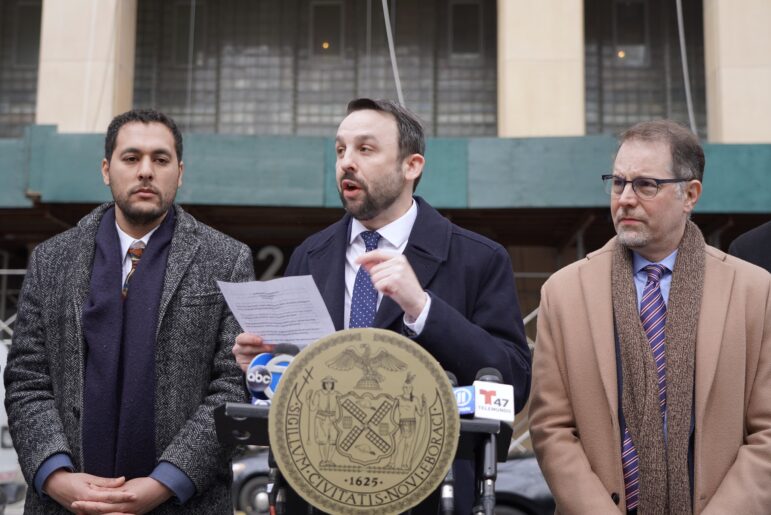
Photo by: Marc Fader
A stalled residential development site in Manhattan, one of dozens around the city. The collapse of the housing market may have slowed the loss of affordable housing in the city, but as development resumes the pressures will resurface. Meanwhile, the foreclosure crisis, overleveraged private equity buildings, vacancy decontrol and underfunded public housing are challenges advocates want the next governor to face.
With increasing numbers of New Yorkers both in the city and upstate dedicating the lion’s share of their income to housing, and with Buffalo, Syracuse and plenty of downstate neighborhoods still reeling from the foreclosure crisis, advocates were on the look-out for ideas of how to address the state’s housing needs when gubernatorial candidate Andrew Cuomo released a detailed urban agenda at New York City Hall last week.
But while there are plenty of worthwhile initiatives in the former U.S. Department of Housing and Urban Development secretary’s plans, advocates say, there are few bold ideas. And what is left out is as revealing as what is included. Cuomo talks about expanding and reinvigorating various financing schemes for building affordable housing and avoiding foreclosures and the blight that can be their aftermath, but he doesn’t say a word about holding on to the state’s existing stock of affordable housing.
“It’s sort of what we expected on the housing production side, which is good, but we were very disappointed that it doesn’t address preservation,” says Victor Bach, senior housing policy analyst at the Community Service Society (which owns City Limits). “We think there are some serious omissions and would encourage him to get serious on tenant protect and preservation.”
Cuomo is not the only candidate with a housing agenda. Besides the Rent Is Too Damn High’s eponymous housing platform, there is Charles Barron’s Freedom Party, whose multipoint housing agenda is short on detail but includes a moratorium on evictions from public housing and a ban on the use of eminent domain to clear land for private developers–a point on which Libertarian Warren Redlich, who says little else about housing, agrees. Green Party candidate Howie Hawkins wants to create a state bank to refinance affordable mortgages and give New York City home rule on rent control laws—a long-standing ambition of housing advocates.
Despite his background as a real estate developer, Republican Carl Paladino has said almost nothing about housing other than that he wants to shut down the state’s housing department.
However, with his commanding lead in the polls, Cuomo’s housing policy is the one most likely to matter come January 1.
A focus on federal funding
Over twenty pages in his Urban Agenda document, Cuomo articulates what he says will be priorities if he becomes governor. He’ll push to make the federal Low Income Housing Tax Credit program more attractive to investors. The tax credit program has been a bedrock of financing the development of affordable housing since it was introduced in 1986, but in the economic decline of the past two years, investment banks that usually purchase the credits slowed down their investment, particularly in upstate projects, Cuomo said. “LIHTC investments dramatically declined upstate, creating gaps in financing,” Cuomo said in his blueprint. He says he’ll work with Congress to reformat the program so investors start buying again and cash is once again flowing to affordable housing developers. But he doesn’t get into details.
In 2008 Congress approved a National Housing Trust Fund, but they never funded it. If the Obama administration gets the amount it wants in the fund, New York State would see $111 million for affordable housing. Cuomo says he’ll take a leadership role among governors to push Congress to fund the fund.
As attorney general, Cuomo launched several investigations into mortgage fraud and mortgage serving firms engaged in the robo-signing and other questionable foreclosure practices now under scrutiny nationwide.
Foreclosures continue to roil the state, eviscerating gains in homeownership in black and Latino communities and draining the state’s tax base. Between February, when the state Banking Department began keeping track, and October, 134,000 New York State homeowners have received notice that their banks are beginning foreclosure proceedings. Suffolk, Queens, Nassau, Kings and Westchester Counties lead the latest round of foreclosures. (Paladino’s native Erie County came in just below Westchester with 6,167 pre-foreclosure filings in from February to October.)
Cuomo says one way he will minimize foreclosures as governor is by scrutinizing servicers to prevent faulty ones. In response to the aftermath of vacant and abandoned properties that the foreclosure crisis has left in many communities, Cuomo says he’ll establish land trusts, innovative publicly-controlled legal entities that can acquire and maintain large areas of vacant land and strategically manage their return to productive use.
Advocates who have been beating the drum about the problem of over-leveraged apartment buildings—properties bought for exorbitant sums during the real estate boom by owners who thought they could jack up rents on low- and moderate-income tenants—praised Cuomo for including plans to use the power of the state mortgage insurance fund and bank-regulating entities to push lenders to write down the debt on buildings where onerous mortgages are threatening the ability to provide affordable housing.
“We definitely are enthused to see Cuomo’s focus on the issue of overleveraged or predatory equity buildings. We think the ability to tap into mortgage insurance fund resources will only help preserve these buildings as affordable housing, and it’s really getting the details right which will be our challenge going forward,” says Dave Hanzel, policy director at the Association of Neighborhood Housing Developers.
But like nearly all the proposals in the urban agenda, the role Cuomo envisions for the state is primarily advisory or involves the application influence—not the exercise of direct state government authority, which often does not exist in those areas.
Rent regs left unaddressed
Housing finance largely originates at the federal level. Refinancing onerous mortgages is solely the discretion of lenders. State government, however, is firmly in control of rent regulation laws. But Cuomo’s urban agenda makes no mention of them. And while Cuomo garnered praise for grappling with the problem of over-leveraged rental buildings, his blueprint says nothing about Mitchell-Lama units being removed from the system or about protecting rent stabilized tenants from harassment.
“I think its grossly deficient…He said nothing about the fact that we’ve lost probably 300,000 rent regulated apartments from vacancy decontrol,” says Michael McKee, board member of Tenants Political Action Committee and a longtime rent stabilization activist. “You can have all the incentives you want for new construction and it will be a drop in the bucket compared to all the rent regulated units we are losing … [R]ent regulation is an affordable housing plan.”
Rent regulation laws are up for renewal next year, and as ever there will be a pitched fight between real estate interests and tenants over weakening or strengthening dozens of provisions of the regulations. Cuomo reveals nothing about how he’ll navigate those battles.
“It’s been eroded as it’s been continued,” Community Service Society’s Bach says of rent regulations. “The question is whether there will be a further erosion or whether it will be a stand-still, or whether tenants will win some of the protections they’ve been pushing.”
Tenant activists have been trying to repeal vacancy decontrol, the provision by which regulated apartments become market-rate if they are vacated and the legal regulated rent reaches $2,000 a month, since it was reinstated in 1997. When Democrats took control of the State Senate in 2009 they thought their time had come. But the Pedro Espada-Hiram Monserrate coup of 2009 upended those hopes. With both of them out of Albany (Espada lost a primary and Monserrate was removed from office over a domestic violence incident and lost a special-election bid to return) pro-rent regulation activists are again gearing up.
The Cuomo campaign did not respond to several requests for comment and didn’t respond to an email with specific questions about rent regulation laws and financing initiatives. The Real Estate Board of New York, which traditionally lobbies for fewer regulations on landlords ability to charge market rent, was unable to immediately respond to a request for comment, a spokeswoman said.
Housing as jobs
Cuomo’s plan is also mum on funding for public housing. The state still controls 15,000 units outside the five boroughs, Bach said. The administration of Gov. George Pataki ceased all funding for operational funding and local housing authorities have been struggling to maintain their stock since. David Muchnick, coordinator at the advocacy coalition Housing First! says the plan misses the boat by talking about developing new affordable housing without linking that drive directly to job creation. With the state so desperate for jobs, it would be far easier to secure money for housing if it is presented as a jobs initiative, Muchnick says. He suggests floating new capital bonds to finance construction.
“Right now the state is investing essentially less than one 100th of 1 percent of its cash receipts in affordable housing. If it were only to invest five 100s of 1 percent it could recover over 1,600 jobs and make up many lost since the recession began,” Muchnick argues. “That would mean $33.5 million in debt service on $500 million capital program. Somebody smart in the budget bureau ought to find a way to get that kind of money freed up.
“As much of a deficit as we have, we need to find a way to use affordable housing to create jobs, because it is a job generator and economic development opportunity,” Muchnick says.








